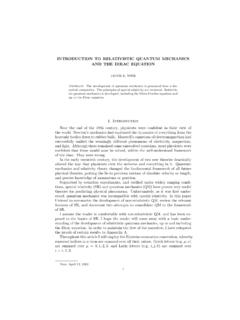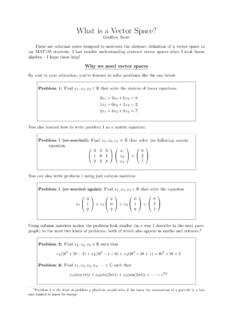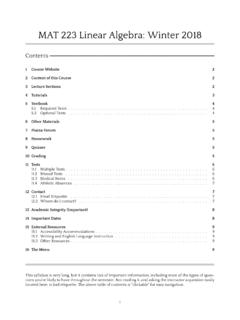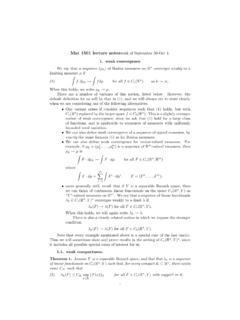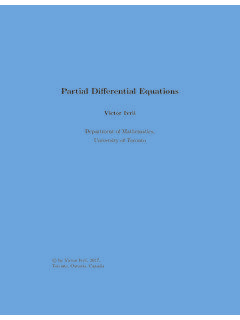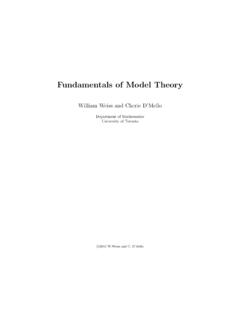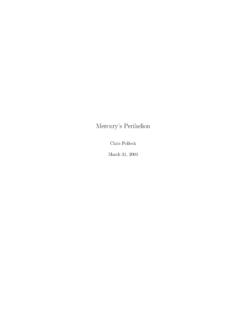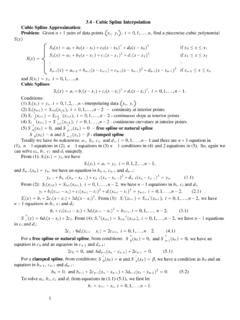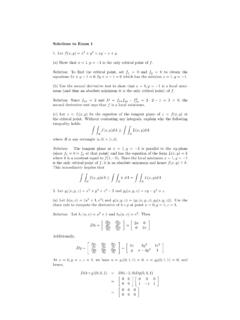Transcription of 6. L’Hˆopital’s Rule - » Department of Mathematics
1 6. L H opital s RuleEveryone knows that 0/1 = 0. What do we mean when we say that 1/0 = or , or does not exist ? , limx 1xx 1is infinite or does not exist. We can t actuallydivide by zero; we mean something like the example above, that is, if limx af(x) = 1 andlimx ag(x) = 0 then limx af(x)g(x)is infinite or does not exist .This much you more or less knew already, but what is limx af(x)/g(x) if limx af(x) = 0and limx ag(x) = 0? We call this a 0/0 0ex 1x= 1orlimx 2(x+ 2)12 2(x+ 6)13 2= 3 How do we find these limits? There is a useful procedure known as L H opital s H opital s RuleIf limx af(x) = 0 and limx ag(x) = 0 andlimx af (x)g (x)=Lthenlimx af(x)g(x)=Las well.(There are additional assumptions onfandg, but these are commonly satisfied bythe functions we deal with in this course, so we shall skip the details.)In other words, if you are trying to evaluate limx af(x)/g(x) and it is of the form0/0, then try limx af (x)/g (x).
2 If you get an answer, thesameanswer will work forlimx af(x)/g(x).1In our examples,ex 1xis in 0/0 form atx= 0. Also(ex 1) (x) =ex1and limx 0ex1=e0= 1 Therefore limx 0ex 1x= 1.(x+ 2)12 2(x+ 6)13 2is in 0/0 form atx= 2. Also((x+ 2)12 2) ((x+ 6)13 2) =12(x+ 2) 1213(x+ 6) 23andlimx 212(x+ 2) 1213(x+ 6) 23=12121314= 3 Thereforelimx 2(x+ 2)12 2(x+ 6)13 2= 3 Why does this rule work? Notice that iff(a) = 0 andg(a) = 0 thenf(x)g(x)=f(x) f(a)g(x) g(a)=f(x) f(a)x ag(x) g(a)x aSolimx af(x)g(x)= limx af(x) f(a)g(x) g(a)= limx af(x) f(a)x ag(x) g(a)x a=f (a)g (a)Iff (a)g (a)makes sense, andf(a)g(a)is in 0/0 form, thenlimx af(x)g(x)=f (a)g (a)This is called L H opital s Rule. (The foregoing calculation has a number of technicalshortcomings. Nevertheless, it does embody the central idea of a rigorous proof.)Notice that L H opital s rule doesn t work if limx af(x)6= 0 or limx ag(x)6= 0. 1x2x= 16= limx 1(x2) x = limx 12x1= 22 Sometimes, L H opital s Rule needs to be applied more than once; , checking thatwe still have a 0/0 form each time before we apply the derivative to both numerator anddenominator,limx 0ex 1 xx2= limx 0ex 12x= limx 0ex2=12L H opital s Rule works in another case besides 0/0 forms.
3 It works on expressions ofthe form / ; ,limx exxis of the form / and(ex) (x) =ex1. Since limx ex1= , it follows thatlimx exx= .Another example: find limx 0+xlnx.(This is of the form 0 ( ). In case you think that 0 is always zero or maybeinfinity, notice that limx 0x 1x= 1.)First, turn the expression into a / 0+xlnx= limx 0+lnx1x(this is of the form / )= limx 0+1/x 1/x2= limx 0+( x) = 0It would have been more correct to omit the last = sign and to say instead: thereforelimx 0+xlnx= 0 ; but the circumlocution gets tiresome after a does L H opital s Rule work in these infinite cases? The argument is a littleinvolved, and not so transparent, hence we won t present it here; but see Problem 11 x2ex= limx 2xex= limx 2ex= 03In fact, any power ofxovereaxwill go to zero asxgoes to + as long asa>0. ( / )= limx ( / )=..100 applications of L H opital s Rule later= limx 100!
4 (.00001) 0since the numerator, though enormous, does not change, while the denominator, thoughit looks small for all reasonable values ofx, still goes to asxgoes to . To appreciatehow powerful this method is, notice that if you try substituting some numbers to guessthe limit:x= 2 gives approximately 1030, whilex= 10 gives approximately seems to be approaching 0 asxgets large; but it does!L H opital s rule can be used on other kinds of limits if they can be manipulated so asto require the evaluation of a 0/0 or / , findlimx (1 +ax)x(1 )Lety=(1 +ax)x. Thenlny=xln(1 +ax)=ln(1 +ax)1xwhich is in 0/0 form asx . Hence,limx lny= limx 11 +ax( ax2) 1x24simplifying algebraically= limx a1 +ax=aSo lny aasx .y=elny eaasx ; that is,limx (1 +ax)x=ea(Remember continuous compounding?(1 +rn)nt ertas n .)Exercises1. limx 0ax 1xa>02. limx 0+1 ex x3. What s wrong with the following calculation?
5 Limx 1x3+x 2x2 3x+ 2= limx 13x2+ 12x 3= limx 16x2= 3(The answer is really 4.)4. limx 1+(lnx)2(x 1)25. limx 0ex 1 x x22x36. limx 0(1 + 3x)12x7. limx 1x2x 18. limx 1+(x 1)lnx9. limx (2x 32x+ 5)2x+110. limx 0(1ex 1 1x)11. If the limits off(x) andg(x) are both infinite asx a, then the limits of 1/f(x) and1/g(x) are both 0 asx (x)g(x)=1g(x)1f(x)which is in 0/0 form. Apply L H opital s rule to this second expressionand solve for limx af(x)g(x)to get an idea of why the rule works for / .6


